Gina Badalaty
Sun, September 24, 2023
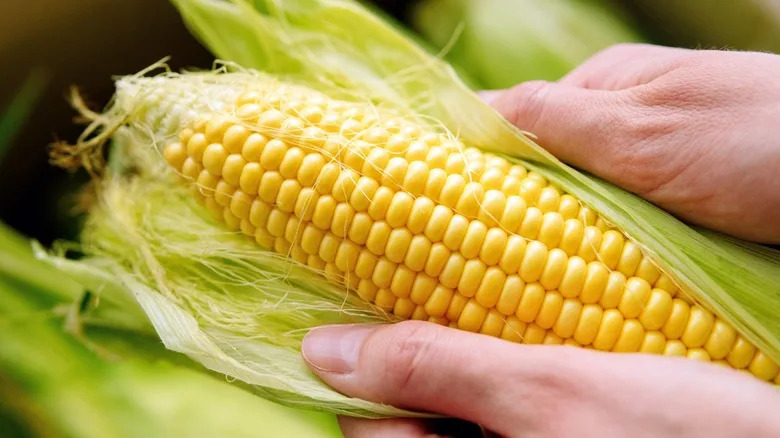
hand holding ear of corn - Infusorian/Shutterstock
Corn is everywhere in the American household. This ubiquitous crop is on our plates, in our products, and even in our gas tanks. Maybe it's because of its versatility -- it can be considered a vegetable or grain, depending on when you harvest it. Because it has been modified to resist all kinds of external threats, a bumper crop is ensured every time so you can have perfect corn on the cob every summer.
Yes, corn is a modern wonder of technology found everywhere thanks to Big Agriculture (Big AG) -- those corporate entities that make millions from pushing factory-farmed corn across the country.
But this abundant crop has a dark side. Industrial farming with advanced technology has done far more harm than good to the planet, farmers, cattle, and workers. There are even questions about the health impacts and safety of Big AG corn.
The way America farms corn puts the entire industry and our food supply at risk. There are many things that the corn industry does not want you to know.
Read more: Mistakes You're Making With Your Corn On The Cob
Corn Farming Methods Increase Air Pollution
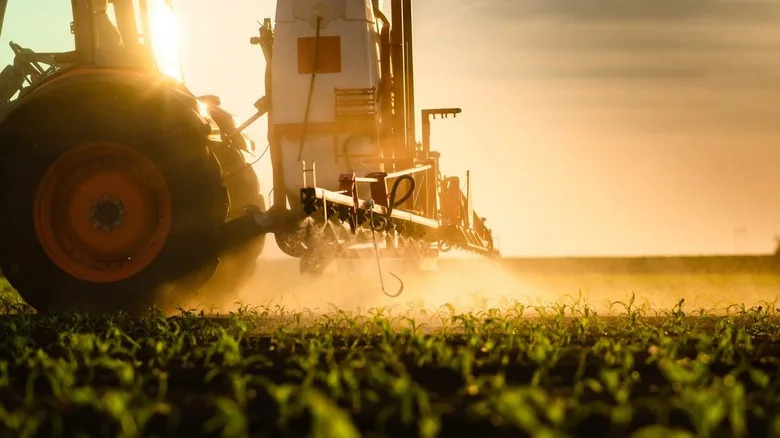
tractor and corn crops - Fotokostic/Shutterstock
Right off the bat, corn farming was recently found to be one of the top causes of air pollution. Studies show that 16% of all pollution caused by humans can be attributed to industrial farming processes including fertilization, seeding, and harvesting. These processes cause small, toxic particles to enter the atmosphere that we can actually inhale.
Recently, some researchers wanted to explore this problem in more depth. In the first study of its kind, the journal Nature Sustainability published a 2019 report that broke down each process involved with industrial corn farming and how they contribute to air pollution. They looked at the entire pre-harvest process around the U.S., from farming to fertilizer manufacturers. By combining corn production and emission models with what is known about how pollution impacts human health, they discovered that corn farming could be responsible for a stunning 4,300 premature human deaths per year.
GMO Corn May Be Bad For You

inspector looking at corn crop - Casarsaguru/Getty Images
Most corn in the U.S. today is produced by Big AG. These companies use genetically modified organisms (GMOs) to create herbicide-resistant corn. Bt corn is a GMO that carries a pesticide to ward off pests. The health hazards of this product are hotly debated. GMO foods have been accused of being an allergy trigger even though research shows that they are no more likely to cause an allergic reaction than their non-GMO counterparts.
Another accusation links GMOs to cancer and other health conditions. While the American Cancer Society has said there is no evidence linking the GMO pesticide, glyphosate, to cancer, the International Agency for Research on Cancer, part of the World Health Organization (WHO), called GMOs a potential carcinogen in 2015. The WHO dismissed the study, calling it tainted, but the agency disagrees. That said, many other studies are calling the safety of glyphosate into question. For example, new research has linked it to non-Hodgkin lymphoma.
Another challenge of GMO crops is that it allows for the rise of super pests. In Canada, the corn borer -- a moth that can devastate crops -- adapted to resist genetic modifications. Over time, according to some researchers, a similar resistance could become widespread among moth populations. If crops are at risk from pesticide-resistant pests, stronger -- and potentially more harmful -- solutions may be developed to protect corn.
Industrial Corn Farming Creates Toxic Algae
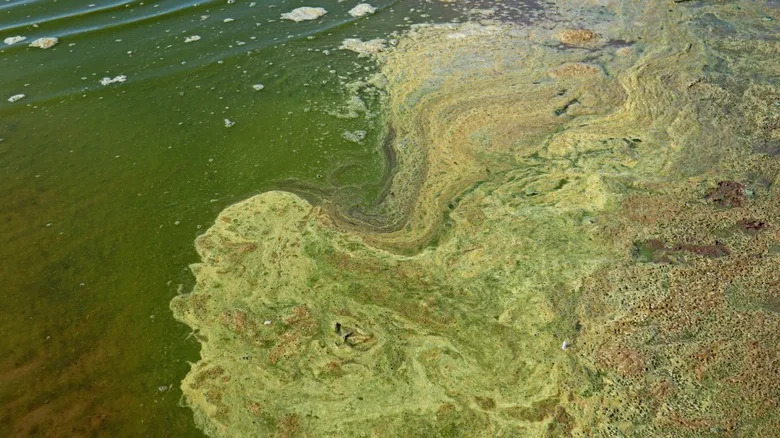
toxic algae in water - mivod/Shutterstock
Most of us understand that our oceans are polluted by many byproducts of modern convenience. Corn is no exception. Across America, our watershed resources are falling victim to toxic algae. This issue is primarily caused by industrial corn farming. These algae blooms come from the runoff of the phosphorus and nitrogen found in corn fertilizer. Algae outbreaks force authorities to shut off water supplies, which can cause water shortages.
Ironically, these fertilizers were promoted as an eco-friendly way to farm. The U.S. Farm Bill has authorized programs in the past that encouraged fertilizer runoff. Although they are not harmful themselves, they create a toxic form of algae in the water. Even the Environmental Protection Agency recognizes "nutrient pollution" as one of the country's worst problems contributing to climate change.
The issue is so prevalent that NASA recently designated satellite tools to track these algae blooms, which can clearly be seen from space. They estimate that nearly 2,000 tons of marine life have been killed due to these blooms, including fish, sea turtles, and marine mammals. And that damage is not just limited to wildlife. When algae come ashore at beaches, harmful toxins are released into the air that can cause respiratory problems in humans.
Corn-Based Ethanol Could Be Even Worse For The Environment Than Gasoline
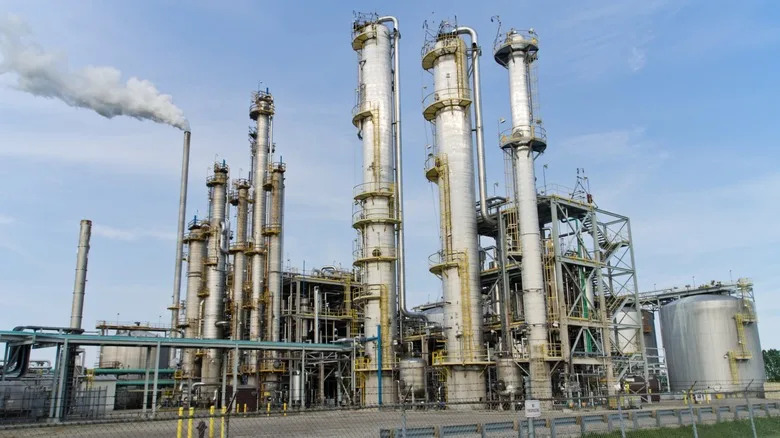
ethanol factory blowing pollution - Simplycreativephotography/Getty Images
A recent study shows that ethanol, derived from corn, contributes far more to global warming [Note: That's a fairly well disguised misinformation site, hence the slide exclusion.] than regular gasoline. The research was published in February of 2022 and was partly funded by the National Wildlife Federation and the U.S. Department of Energy. The study concluded that ethanol releases far more carbon into the atmosphere than gasoline derived from petroleum. The main culprit here? Once again, industrial farming deserves the credit.
This study examined the U.S. renewable fuel standard, which has regulated fuel standards since 2005. The regulation requires all fuel produced in the U.S. has renewable fuel mixed into it. In other words, all standard gasoline available today has ethanol mixed in. Since then, the corn industry has grown and greatly profited from this regulation.
The Renewable Fuels Association accuses the study of faulty methods and incorrect assumptions. In 2019, the U.S. Department of Agriculture performed its own study, which claimed that the carbon emission of ethanol was far below gasoline. The debate continues, but with climate change at the forefront of politics, the corn industry needs to answer for its process.
Corn Crops Are One Of The Most Wasteful
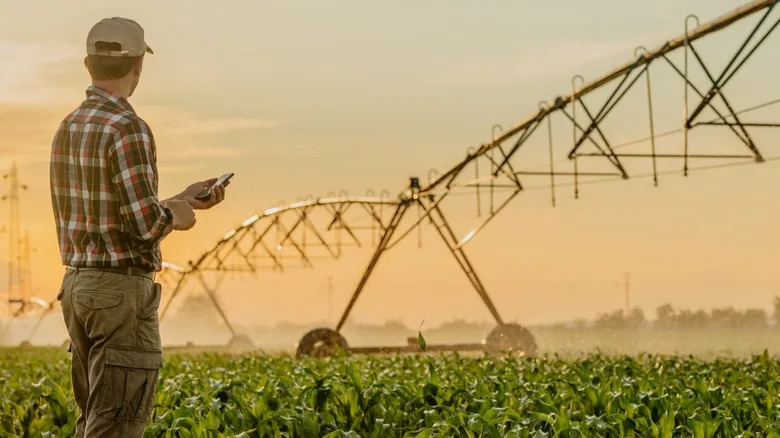
man irrigating corn crops - Simonskafar/Getty Images
Factory-farmed corn is an incredibly wasteful crop. First, it requires a large amount of water to thrive. Because the corn industry is so immense -- comprising about a third of all industrial farming in America -- that the need for water during dry seasons and periods of drought is high. Irrigation must be employed, but as of 2017, corn uses more irrigation water than any other crop in the U.S. with some 12 million acres of irrigated farmland. Some systems are inefficient, too. The increased need for irrigation also leads to more fertilizer runoff and nutrient pollution.
Plus, much of the harvested crop ends up as waste. Only about a third of America's corn harvest is used for food today; the rest is split equally between ethanol and livestock feed. Nearly 50% of harvested plants are tossed aside and burned by many corn producers, including stalks, leaves, husks, and cobs. Researchers are now seeking ways to repurpose this corn waste into activated carbon rather than add more injury to the environment with these fires.
Corn Is Harmful To Ecosystems Around The Globe

man inspecting corn crop - Casarsaguru/Getty Images
From the U.S. to Brazil to the Amazon rainforest, the demand for corn has led to a loss of natural ecosystems. Factory-grown corn relies on monocropping, which destroys the beneficial biodiversity found in nature.
In traditional farming, land and crops are rotated. This is key to keeping the soil healthy, ensuring a plentiful harvest every season. Industrial farming, on the other hand, employs monocropping -- the process of exhausting the land by planting the same thing over and over. How did it become so popular?
Decades ago, global leaders wanted to create solutions to combat hunger. They believed that monoculture was the best way to increase crop yields. By creating large industrial farms dedicated to a single crop, they saved time and money.
However, with monocropping, when a crop fails -- as it might during a drought or when pests successfully work their way through the field -- it fails spectacularly.
But it gets worse. Countries around the world are destroying their native ecosystems to plant this monocrop. For example, Brazil's increase in corn production has increased deforestation of the Amazon Rainforest. And in Africa, water resources in areas at risk of drought are being depleted by corn irrigation. Such widespread loss of natural biodiversity and resources leaves us at serious risk of a global environmental disaster.
Industrial Corn Farming Creates New Risks

corn borer on corn cob - Bigc Studio/Shutterstock
Industrial corn farming also can breed new diseases. Scientists are already warning that a new pandemic danger could arise that impacts high yield crops instead of people. Once again, monocropping is at the root of the issue. When so many acres of farmland are dedicated to a single crop, the risk of a virus or bacteria wiping out much of the yield is comparatively high.
It's happened before. In the 1970s, a fungus swept through the U.S. Corn Belt, devastating 15% of the anticipated harvest. And today? Recently, a new bacterial disease spread through corn fields in one of those corn belt states: Texas. This fungus cost some farms up to 90% of their crops. The pathogen first struck in 2021 during a fungicide trial and in 2021 at seven farms. The corn industry could look for ways to re-introduce biodiversity to farming methods to protect both crops and the affected ecosystems.
Corn Crops Cause Soil Degradation
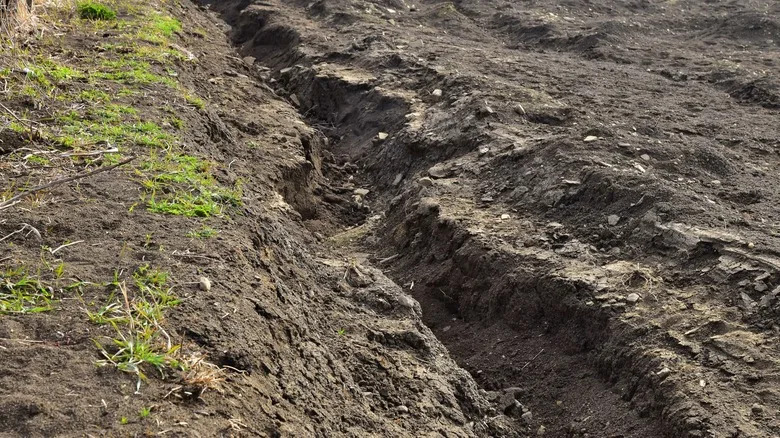
field soil degradation - Meryll/Shutterstock
There is yet another ecological challenge of industrial corn farming: Soil degradation. In 2021, satellite imaging demonstrated that the American Corn Belt has lost at least a third of its topsoil, with some farms losing as much as 50%.
That poorer soil quality means worse yields of corn, which could be quite a blow since this region produces 75% of corn in the U.S. And soil degradation is costing farmers millions of dollars in fertilizer to compensate for increasingly infertile soil. In other words, more and more nitrogen- and phosphorus-rich fertilizer is required, which contributes to greenhouse gas emissions and toxic algae in a vicious eco-cycle.
The farming industry must seriously consider rethinking its processes to maintain crop yield while protecting the environment; the current paradigm does not appear remotely sustainable. Better tools such as regenerative agriculture can help restore soil integrity and reduce costs, but will the corn industry listen?
Corn Feed Harms Cattle

Doctor looking over cattle - Tomazl/Getty Images
As mentioned, one-third of all factory-farmed corn is used for livestock feed. Unfortunately, this feed can lead to pain, illness, and death for livestock. Cattle are natural grazers. Their bodies are designed to ingest and process grass and other fiber-based foods. This helps maintain the microorganisms in their stomach system and aids in digestion, keeping the animals healthy.
Unfortunately, cattle grazing is more expensive for farmers than feeding them grain. Since corn is overproduced, it's cheaply available as feed. Feeding cattle grain is also more convenient for monocropping than grazing. It makes cattle gain weight faster, which is good for the beef industry.
Despite these benefits, eating grain is harmful to cattle. These animals have a unique stomach system adapted to eating grass, not grains. Eating grains causes gas buildup, making them bloat. This leads to inflammation that stresses their lungs, which can get so bad that cattle may slowly die of asphyxiation.
Besides this agonizing death, corn feed can cause other health issues in cattle, including abscess, tumors, and acidosis, which are prevalent among factory-farmed cattle.
Industrial Corn Farming Is Killing Small Farms

father and son on farm - Maksim Shmeljov/Shutterstock
Small- and medium-sized family farms are being gradually pushed toward extinction. The numbers prove it. In a 12-month period, farm bankruptcies increased 50% in the Northeast and 12% in the Midwest, in 2019. While several factors contribute to this phenomenon, the rise of factory farming, especially from products like corn, is the prominent cause.
How did this happen? In the '70s, the government pushed smaller farms to massively increase production. Many complied, but in 10 years, overproduction led to skyrocketing costs. This put many farms upside-down in debt. Some went bankrupt, leading corporations to sweep in to pick up the slack. These corporate farms make CAFOs -- short for "concentrated animal feeding operations." Today, CAFOs are the only way to run a farm and still earn a profit. Most small farms were forced to change from traditional farming, including dairy or livestock, to corn and soybean farming to stay alive. The crop is then sold as cattle feed for Big AG companies.
Some farmers claim that companies game the system by intentionally keeping prices low, hiring cheap labor, and preventing the remaining farmers from earning more. This caused many Midwestern farming towns to die out or slide into poverty as the CAFO companies turned a big profit.
Most Corn Is Grown On Farm Subsidies
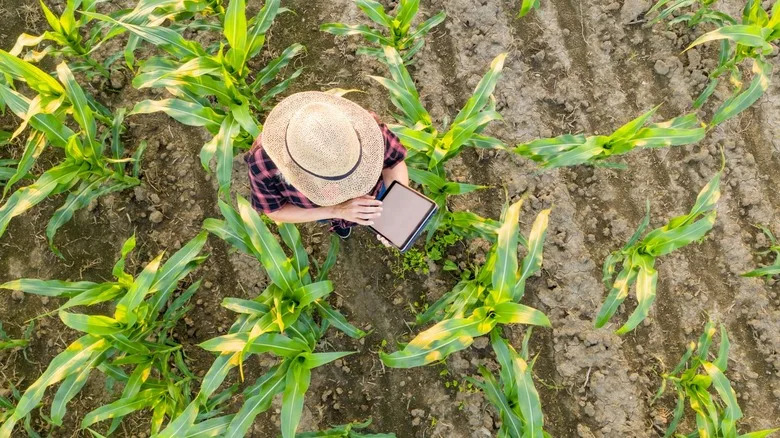
female farmer with tablet - Simonskafar/Getty Images
Once the continual overproduction of corn became a reality, farmers needed subsidies supported by American taxes. This is another hotly debated issue, but many small farmers believe they have done more harm than good.
One point of contention is the problem of who truly benefits from farm subsidies. They should benefit farmers, but if they did, why would so many farms go bankrupt? However, there is conflicting information on this topic. The Cato Institute states that corn, soybeans, and wheat farmers get 70% of subsidies. Yet in 2018, Forbes found that the top 10 subsidy recipients earned over $150 million from their farms. Most commonly, subsidies go to the landowners. However, most working farmers today rent and, thus, do not receive any subsidies.
Subsidies encourage and support the proliferation of factory farming, which can harm the environment, cattle, towns, and people. And since they are regulated under the U.S. Farm Bill, which is reviewed by Congress every few years, this regulation can come with political strings attached, further muddying the integrity of the corn industry.
Corn Farms Exploit Laborers

worker with corn plant - encierro/Shutterstock
Most people know that many farm workers come to America from Mexico and other Central and South American countries to find jobs. You might not know how these workers are treated at industrial corn farms. They are hired by factory farms and paid very little, often less than the low wages they are promised.
As if that wasn't bad enough, some workers are actually trafficked. Workers are lied to about where they will work and then relocated to other farms. Housing conditions can be deplorable, with issues ranging from lice and roach infestations to broken water and bathroom facilities. But that's nothing compared to how they are treated.
One worker speaking to The Guardian revealed the details of a farm trafficking ring in Georgia. He was forced to work 12-hour days for 15 days straight for a total of $225. After that, he was moved to another farm to work for free and eventually returned to Mexico. Other migrants harmed by this ring claimed they were abused, tortured, or raped, and two workers died. Fortunately, this trafficking program was discovered and at least 24 defendants were indicted.
Unfortunately, investigation into this type of trafficking by the U.S. Department of Labor has significantly dropped over the years. This can lead to many more criminal trafficking organizations preying on migrant workers.
No comments:
Post a Comment